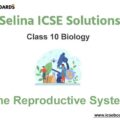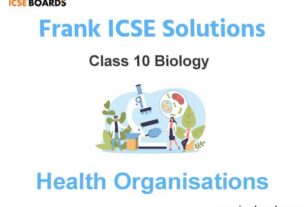Question 1: Name the following:
(i) Organ producing sperms.
(ii) Organ producing ovum.
(iii) Organ where implantation takes place.
(iv) Organ where fertilization occurs.
(v) Fusion of sperm and ovum.
(vi) Virgin birth
(vii) Male and Female organs on specific individuals.
Solution 1:
1. Organ producing sperm is Testes
2. Organ producing ovum is Ovary
3. Implantation takes place in Uterus
4. Fertilization occurs in the Oviduct
5. Fusion of ovum and sperm is known as Fertilization
6. Virgin birth is Parthenogenesis
7. Male organ is testis and female organ is ovaries.
Question 2: Complete the following statement by choosing the correct alternative:
(i) Male copulatory organ ______. (clitoris, penis, vulva)
(ii) Female copulatory organ ______. (vulva, vagina, penis)
(iii) Fertilization occurs in ______. (uterus, oviduct, ovary)
(iv) Menstrual flow is a character is the feature of ______. (male, female, bulb)
(v) Sterilization in female is due to cutting off of ______. (ovary, uterus, oviduct)
Solution 2:
(i) Male copulatory organ penis.
(ii) Female copulatory organ vagina.
(iii) Fertilization occurs in oviduct.
(iv) Menstrual flow is a character is the feature of female.
(v) Sterilization in female is due to cutting off of oviduct.
Question 3: Give the functions of the following:
(i) Ovary
(ii) Fallopian tube
(iii) Uterus
(iv) Vagina
(v) Testes
(vi) Penis
Solution 3:
1. Ovary: Ovaries is a primary female sex organ it produce ova and secrete the female sex hormones estrogen progesterone which is responsible for development of secondary female sex characters.
2. Fallopian tube: To conduct of the ovum or zygote towards the uteru.i it is also the site of fertilization..
3. Uterus: It is the site of foetal growth during pregnancy. It also takes part in placenta formation and expulsion of the baby during parturition.
4. Vagina: It receives the sperm from penis during copulation. And as birth canal along with cervix.
5. Testes: Testes is the primary sex organ that produces sperm and sex hormone i.e testosterone which is responsible for secondary sex character.
6. Penis: ovulatory organ of man
Question 4: Define the following:
(i) Parthenogenesis
(ii) Asexual reproduction
(iii) Sexual reproduction
(iv) Dioceious
(v) Monoceious
(vi) Clone
Solution 4:
1. Parthenogenesis:- There are some organisms which show a special type of reproduction in which the female gamete develops into a new individual without being fertilzed by a male gamete. This process is know as Parthenogenesis.
2. Asexual reproduction: it is the mode of reproduction in which new individual develop directly from specialised or unspecialised parts of a single parent without involving fusion of gametes or sex cells.
3. Sexual reproduction:- The production of offspring by the fusion of specialised
male and female cells Called gametes. Gametes are haploid and fuse to from the fertilzed egg or zygote, which eventually develops into a new organism.4. Dioceious:- Organism having male and female reproductive organs in separate individuals.
5. Monoecious:- Organism having male and female reproductive organs in the same individual.
6. Clone:- Genetically and morphologically similar individual are known as clone.
Question 5: Define the following:
(i) Parturition
(ii) Ovulation
(iii) Spermatogenesis
(iv) Gestation
(v) Implantation
Solution 5:
1. Parturition:- Vigorous contraction of the uterus at the end of pregnancy causes expulsion /delivery of the foetus. This process of delivery of the foetus is called parturition.
2. Ovulation:- The process of an egg being released from the ovary.
3. Spermatogenesis:- the process in which from one primary spermatocyte four haploid sperms are formed.
4. Gestation:- The time period from fertilization to parturition.
5. Implantation:- embedding of blastocyst into uterine endometrium which occurs at 6-7 day after fertilization.
Question 6: Label the following diagram:

Solution 6:

Question 7: The diagram alongside is the vertical section of female reproductive organs. Study the diagram and answer the questions that follow:

(i) Name the fully developed part of ovary containing the ovum.
(ii) Name the organ of the female body in which the foetus develops.
(iii) What is ovulation?
(iv) Which two hormones are secreted by ovary?
Solution 7:
1. Graafianfollicle
2. Uterus
3. Process of releasing of egg from the ovary is known as ovulation.
4. Oestrogen and progesterone.
Question 8: Given on the right is a diagram which represents the reproductive organs of a man:
(i) Write the names of the parts numbered 1 to 16.
(ii) Give two functions of the part 6.
(iii) Name three components of the fluid which may be found in the tube labeled 2.
(iv) What is the main function of the part labelled 3?

Solution 8:
(i) 1. Peritoneum
2. Ureter
3. Backbone
4. Rectum
5. Seminalvesicle
6. Glands
7. Anus
8. Vasdeferens
9. Epididymis
10. Lefttestis
11. Scrotum
12. Penis
13. Urethra
14. Vascularerectiletissue
15. Bladder
16. Muscular wall of abdomen
(ii) Below are the functions of glands are:-
(a) Prostate gland secrets and alkalinity component of semen.
(b) Cowper’s gland secrets lubicricants.
(iii) The 3 components of urine, urea uric acid, and amino acid.
(iv) The Name of the third part is backbone. Backbone’s major role is to provide support, movement, and protection to the spinal cord.
Question 9: (i) Draw a diagram to display the vertical view of human female reproductive system and label the following parts in the diagram:
(1) Ureter
(2) Ovary
(3) Funnel of fallopian tube
(4) Urethra
(ii) What happens to uterus if fertilization takes place? And what happens to uterus if fertilization does not take place?
Solution 9:
(i)

(ii) If fertilization occurs, the uterine wall thickens and becomes supplied with blood capillaries. The endometrium breaks down if fertilization does not occur, resulting in the release of blood and muscus.
Question 10: Name the following:
(i) The parts of the ovary containing mature ovum.
(ii) Two accessory glands in the male reproductive system.
(iii) The organ of female in which the foetus develops.
(iv) The separation of the foetus from the mother’s body.
(v) The part of the female reproductive system in which fertilization occurs.
Solution 10:
1. Graafian follicle
2. Seminal vesicles andvprostate gland
3. Uterus
4. Parturition
5. Oviduct
Question 11. Diagram shows the reproductive system of female human beings:

(i) Name the parts numbered 1 to 14.
(ii) Normally, after how many days does an ovary release an egg?
(iii) Where are the sperms released during coitus?
(iv) What is the role of sperms after their ejaculation in vagina?
(v) What is the function of the organ numbered 5?
(vi) What is the gestation period in human?
Solution 11:
(i)
1. Fallopian tube
2. Funnel like opening
3. Ovary
4. Uterus
5. Sacrum
6. Rectum
7. Cervix
8. Anus
9. Vagina
10. Front of pelvis
11. Bladder
12. Muscular uterine wall
13. Muscular wall of abdomen
14. Peritoneum
(ii) After 28 days an ovary releases an egg.
(iii) Sperm are released in the vagina, during coitus.
(iv) Sperms are fertilized by merging with a female ovum to produce a zygote after ejaculation in the vaginal canal.
(v) Protect the pelvic organs or reproductive organs of female.
(vi) The gestation period in human is 280 days.
Question 12: State whether the following statements are true or false:
(i) Fertilization occurs in the vagina.
(ii) Gestation in humans is completed in about 380 days.
(iii) Oviducts and fallopian tubes are one and the same thing.
(iv) One egg is released from each of the two ovaries every month.
(v) The vagina is a muscular tube.
Solution 12:
| (i) Fertilization occurs in the vagina. | False |
| (ii) Gestation in humans is completed in about 380 days. | False |
| (iii) Oviducts and fallopian tubes are one and the same thing. | True |
| (iv) One egg is released from each of the two ovaries every month. | False |
| (v) The vagina is a muscular tube. | True |
Question 13. Rewrite the correct statement by changing the last one word if these statements are false.
Pregnancy in women can be prevented by the method of vasectomy. (True/False)
Solution 13:
False, Pregnancy in women can be prevented by the method of tubectomy.
Question 14. Name the membrane that surrounds the foetus and secretes a protective fluid.
Solution 14:
The membrane that surrounds the foetus and secrete a protective fluid is Amnion.
Question 15. Give appropriate terms for each of the following:
(i) The onset of reproductive phase in a young female.
(ii) The rupture of follicle and release of ovum from the ovary.
(iii) The monthly discharge of blood and disintegrated uterine tissues in human female.
(iv) The process of fusion of ovum and sperm.
(v) The attachment of developing zygote (blastocyst) on the uterine wall.
Solution 15:
1. Menarche
2. Ovulation
3. Menstruation
4. Fertilization
5. Implantation
Question 16. Choose the correct answer:
(i) The aim of sexual reproduction
(a) over production
(b) continuity of race
(c) low production
(d) none
Solution:
Continuity of race
(ii) Binary fission is a method of
(a) parthenogenesis
(b) asexual reproduction.
(c) sexual reproduction
(d) none
Solution:
Asexual reproduction
(iii) Ovum is a
(a) male gamete
(b) female gamete
(c) a chemical
(d) a fibre
Solution:
Female gamete
(iv) Virgin birth is called
(a) Sexual Reproduction
(b) Asexual Reproduction
(c) Parthenogenesis
(d) Abiogenesis
Solution:
Parthenogenesis
(v) Cervix is a part of
(a) ovary
(b) vagina
(c) uterus
(d) oviduct
Solution:
Vagina
(vi) Removal of testes is called
(a) regeneration
(b) reproduction
(c) castration
(d) none
Solution:
Castration
(vii) Fertilization occurs in
(a) uterus
(b) oviduct
(c) ovary
(d) vagina
Solution:
Oviduct
(viii) Secondary sexual characters appear in
(a) foetus
(b) childhood
(c) puberty
(d) adulthood
Solution:
Puberty
(ix) The onset of menstruation in the female is termed
(a) ovulation
(b) menarche
(c) menopause
(d) parthenogenesis
Solution:
Menarche
(x) Temperature of scrotum is
(a) 20C above body temperature
(b) same as body temperature
(c) 20-30C below the body temperature
(d) none of the above
Solution:
2°-3°C below the body temperature
(xi) First menstrual cycle is known as
(a) menopause
(b) amenorrhoea
(c) puberty
(d) Menarche
Solution:
Menarche
(xii) When pregnancy does not occur, the life of corpus luteum is about
(a) 4 days
(b) 10 days
(c) 14 days
(d) 28 days
Solution:
10 day






